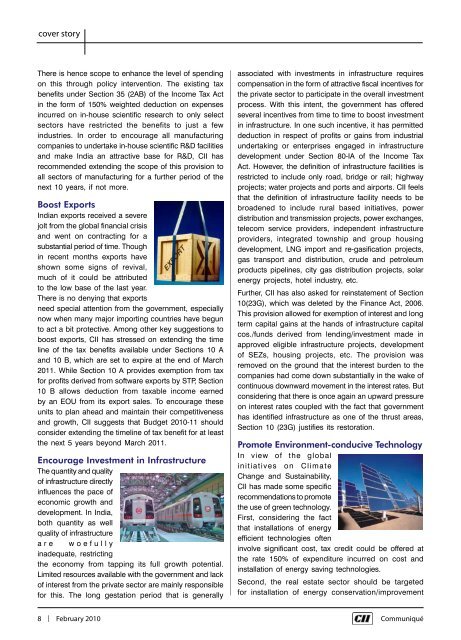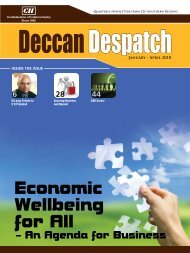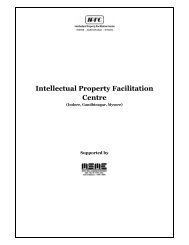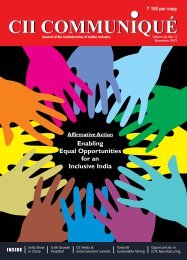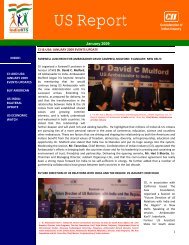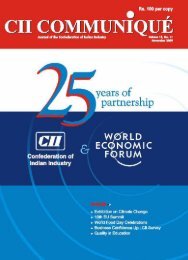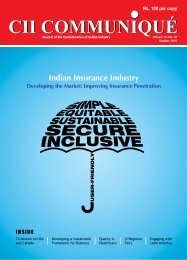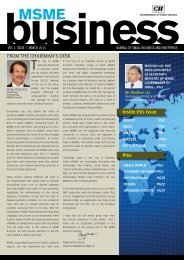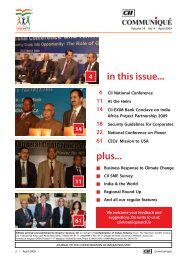CII Communique - February, 2010
CII Communique - February, 2010
CII Communique - February, 2010
You also want an ePaper? Increase the reach of your titles
YUMPU automatically turns print PDFs into web optimized ePapers that Google loves.
cover story<br />
There is hence scope to enhance the level of spending<br />
on this through policy intervention. The existing tax<br />
benefits under Section 35 (2AB) of the Income Tax Act<br />
in the form of 150% weighted deduction on expenses<br />
incurred on in-house scientific research to only select<br />
sectors have restricted the benefits to just a few<br />
industries. In order to encourage all manufacturing<br />
companies to undertake in-house scientific R&D facilities<br />
and make India an attractive base for R&D, <strong>CII</strong> has<br />
recommended extending the scope of this provision to<br />
all sectors of manufacturing for a further period of the<br />
next 10 years, if not more.<br />
Boost Exports<br />
Indian exports received a severe<br />
jolt from the global financial crisis<br />
and went on contracting for a<br />
substantial period of time. Though<br />
in recent months exports have<br />
shown some signs of revival,<br />
much of it could be attributed<br />
to the low base of the last year.<br />
There is no denying that exports<br />
need special attention from the government, especially<br />
now when many major importing countries have begun<br />
to act a bit protective. Among other key suggestions to<br />
boost exports, <strong>CII</strong> has stressed on extending the time<br />
line of the tax benefits available under Sections 10 A<br />
and 10 B, which are set to expire at the end of March<br />
2011. While Section 10 A provides exemption from tax<br />
for profits derived from software exports by STP, Section<br />
10 B allows deduction from taxable income earned<br />
by an EOU from its export sales. To encourage these<br />
units to plan ahead and maintain their competitiveness<br />
and growth, <strong>CII</strong> suggests that Budget <strong>2010</strong>-11 should<br />
consider extending the timeline of tax benefit for at least<br />
the next 5 years beyond March 2011.<br />
Encourage Investment in Infrastructure<br />
The quantity and quality<br />
of infrastructure directly<br />
influences the pace of<br />
economic growth and<br />
development. In India,<br />
both quantity as well<br />
quality of infrastructure<br />
a r e w o e f u l l y<br />
inadequate, restricting<br />
the economy from tapping its full growth potential.<br />
Limited resources available with the government and lack<br />
of interest from the private sector are mainly responsible<br />
for this. The long gestation period that is generally<br />
associated with investments in infrastructure requires<br />
compensation in the form of attractive fiscal incentives for<br />
the private sector to participate in the overall investment<br />
process. With this intent, the government has offered<br />
several incentives from time to time to boost investment<br />
in infrastructure. In one such incentive, it has permitted<br />
deduction in respect of profits or gains from industrial<br />
undertaking or enterprises engaged in infrastructure<br />
development under Section 80-IA of the Income Tax<br />
Act. However, the definition of infrastructure facilities is<br />
restricted to include only road, bridge or rail; highway<br />
projects; water projects and ports and airports. <strong>CII</strong> feels<br />
that the definition of infrastructure facility needs to be<br />
broadened to include rural based initiatives, power<br />
distribution and transmission projects, power exchanges,<br />
telecom service providers, independent infrastructure<br />
providers, integrated township and group housing<br />
development, LNG import and re-gasification projects,<br />
gas transport and distribution, crude and petroleum<br />
products pipelines, city gas distribution projects, solar<br />
energy projects, hotel industry, etc.<br />
Further, <strong>CII</strong> has also asked for reinstatement of Section<br />
10(23G), which was deleted by the Finance Act, 2006.<br />
This provision allowed for exemption of interest and long<br />
term capital gains at the hands of infrastructure capital<br />
cos./funds derived from lending/investment made in<br />
approved eligible infrastructure projects, development<br />
of SEZs, housing projects, etc. The provision was<br />
removed on the ground that the interest burden to the<br />
companies had come down substantially in the wake of<br />
continuous downward movement in the interest rates. But<br />
considering that there is once again an upward pressure<br />
on interest rates coupled with the fact that government<br />
has identified infrastructure as one of the thrust areas,<br />
Section 10 (23G) justifies its restoration.<br />
Promote Environment-conducive Technology<br />
In view of the global<br />
initiatives on Climate<br />
Change and Sustainability,<br />
<strong>CII</strong> has made some specific<br />
recommendations to promote<br />
the use of green technology.<br />
First, considering the fact<br />
that installations of energy<br />
efficient technologies often<br />
involve significant cost, tax credit could be offered at<br />
the rate 150% of expenditure incurred on cost and<br />
installation of energy saving technologies.<br />
Second, the real estate sector should be targeted<br />
for installation of energy conservation/improvement<br />
8 | <strong>February</strong> <strong>2010</strong> Communiqué


